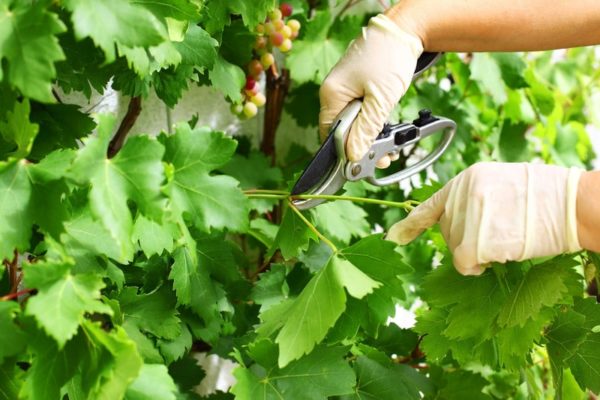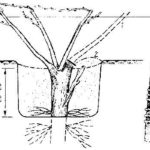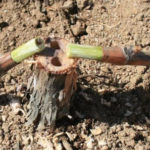Grapes are a real decoration of the garden. From its leafy vine it turns out a magnificent arbor. Aesthetic pleasure when admiring the chic ripening clusters gives way to no less pleasant feelings experienced when eating berries. However, before enjoying juicy berries, it is necessary to plant a vineyard. After that, take care of him, form the bushes, plant and multiply. Think hard? Not at all! Care is pretty simple.
Table of contents
How to care for grapes in spring and autumn
Agrotechnics of this culture is simple, but some nuances that affect the yield, still exist.
The correct garter for beginners
Proper care begins with the garter. The vine, whether it is of medium growth or vigorous cannot grow normally on the surface of the ground, therefore it is tied up. Before holding the garter you need to identify the branches that require fixation. These should be wooded vines, not green shoots.
There are several ways of garter, each of them has not only advantages, but also disadvantages.
- Placing the vine vertically upwards provokes abundant development of the upper buds and weak growth, and the absence of flowering of the lower shoots. As a result of such a garter, the base of the bush becomes bare, and the upper part of the bush grows rapidly,which complicates its placement on the trellis. In addition, it is difficult to prune the branches and shelter the plant for the winter. Therefore, this method is recommended to use only when absolutely necessary.
- Fixing the vine vertically down it is used in long-sleeved and high-stem shrubs. The disadvantage of this method is the wrong location of the bulk of the green growth, which drowns the growth of young shoots.
- Tilt up enhances the growth of lower shoots, and slightly muffles the development of the upper part of the vine. The disadvantages of this technique are the same as that of the vertically upper garter, but the one-year increment is distributed more evenly.
- Horizontal garter provides a uniform supply of power to the eyes and shoots of all levels of the vine. The bush is well ventilated, illuminated by the sun, the growth is evenly distributed along the trellis. This option is considered the most preferred and enjoys great popularity among industrialists and gardeners. Virtually no drawbacks, except that there is a smaller brush formation at the base of the grapes.
- Garter arc stimulates the development of the middle part of the vine.The one-year growth does not develop equally, so this one is inferior to the horizontal fixation of the branches.
- Fixing the vine in the form of a ring stimulates the growth of the middle part of the vine, which repeats the arc-shaped method. However, the looping reinforces the disadvantages of growth and baldness of the base of the bush.
- Often when the garter using the combined method. Typically, this method is used to obtain one-year growth in order to root it and subsequent disembarkation.

Formation of bushes in the first and subsequent years
Before becoming familiar with the rules of trimming the bush should be familiar with the basic principles of this procedure. In the first year after planting the seedlings grow a strong and healthy vine (shoulder). In the autumn it is not cut, it is for it will be in the future the entire flow of nutrients, followed by distribution of the shoots.
From the shoulder in the next year of development of young sprouts. In the fall when pruning leave the 3 strongest branches (sleeves). The interval between the arms developing from the upper buds should be within 80 cm. Fruit shoots sprout on them annually. At the end of the season they are pruned.
It is necessary to form a bush from the first or second year of development of a sapling after planting, and continue for 3-6 years. The duration of work on the trunks is determined by the biological characteristics of the variety and the climate of the region.
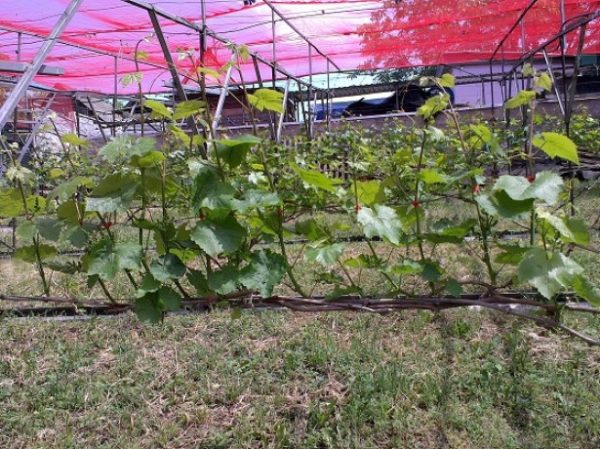
Guyo pruning
Bezshtambovaya molding is more suitable for regions with a harsh climate, it is possible even in summer. The essence of the method lies in the cultivation in the first year of a strong shoot, followed by autumn pruning. From the surface of the soil and above the site of vaccination, 2 eyes should be left (or 3 for insurance). In the second year, shoots grown from the eyes are cut as follows:
- the first one is short with 2-3 eyes, subsequently forming a knot of substitution;
- second long, forming a fruit vine.
In spring, the vine is tied to the trellis in a horizontal way. After harvesting in the fall, you need to remove the fruit vine under a twig, resulting in two young shoots. The following years, the principle of molding is repeated.
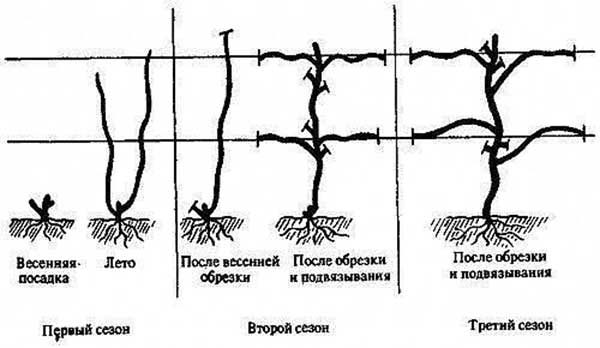
Fan shaping for a great harvest
This method is suitable for regions with difficult climatic conditions. It differs from the Guyot method in that there are 3-6 sleeves on the shoulder, and sometimes more. The vines are tied up on a trellis in the form of a fan, whence the name of the method of forming came from. Depending on the length of the sleeves, branches can be modeled in different versions:
- single or multi-tiered;
- single or double sided;
- short or long sleeves;
- standard or shamless.
The first two years the bush is formed as well as by the method of Guyot. For the third season they are accepted for creating sleeves. The primary goal is to grow 2 shoots on each vine. In the fall, the grown branches are cut to the length of the sleeve, but not less than 50 cm, and then tied to a trellis in the form of a fan.
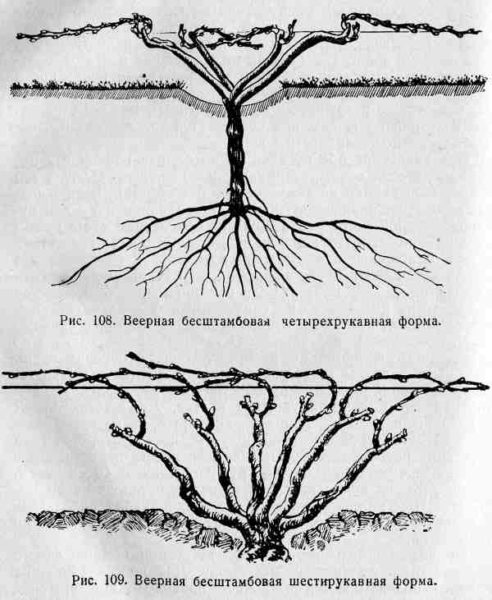
Regardless of the chosen method of trimming the bush, it is recommended to adhere to important rules:
- wounds on both sides of the shoulder are prohibited;
- awakened buds to the level of 60-70 cm from the soil surface should be broken out (forming begins above this point of growth);
- the slope of the shoulder should have an angle of about 30 ° so that the vine does not crack and does not lean to the ground;
- spring garter perform horizontally.
Spraying and good watering
Compliance with the rules of agricultural technology does not protect against the development of typical diseases and pest attacks, therefore many gardeners resort to spraying the bushes with special preparations. Sometimes the treatments are the only guarantee of the safety of the crop.
Attacks of infections and insects are particularly susceptible to the most delicious varieties of culture. Long rains can also cause damage to berries. And in conditions of high temperature and high humidity, the fungus develops quite quickly.
The choice of modern drugs for diseases and pests is very large, but sometimes it is enough to do with the usual means: Bordeaux liquid or copper sulfate solution.When using complex fungicides will be able to protect themselves from several types of fungal infections. Among gardeners, Topaz is a popular drug that prevents dangerous diseases such as mildew and oidium.
After the grapes have flowered, it is important to have time to spray the fungicide. As soon as the berries are formed to the size of the peas, the bushes need to be treated with Bordeaux mixture (colloidal sulfur, copper chloroxide), but this time it is allowed to spray only the brush.
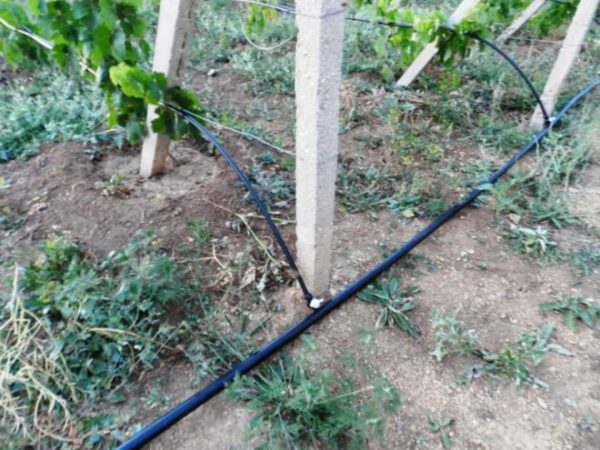
Total for the season is carried out 4 preventive treatments. In case of detection of signs of illness or insects, the treatment is done after rain after 2 hours or sprayed the bushes in a cyclic manner.
Watering the grapes is not so often, but abundant. Should be guided by soil moisture.You should not get involved in water procedures, an excess of moisture provokes the development of fungus. The grapes are particularly in need of watering after planting seedlings, before the flowering period and in the fall after harvesting.
Top dressing and its terms
Intensively developing vine requires feeding with a nutrient mixture. The following fertilizers are used during the growing season:
- before opening the bushes after wintering, they are poured with a solution (20 grams of superphosphate, 10 grams of ammonium nitrate, 5 grams of potassium salt per plant are taken per bucket of water);
- 10-14 days before the start of flowering, feed is introduced from the same components and proportions;
- when green berries reach pea size, the soil is fertilized with superphosphate and potassium salt (nitrogenous substances are not used at this stage);
- after collecting the clusters, the bushes are fed with potash substances to increase the winter hardiness of the crop.
To enrich the soil with micronutrients, it is recommended to apply manure in combination with wood ash, superphosphate, and ammonium sulphate once every 3 years.The mixture is evenly distributed on the surface of the soil, after which the plot is dug up. Autumn work on soil fertilization is increasing, depending on the sand content (sandy type - 1 time in 2 years, sandy - annually).
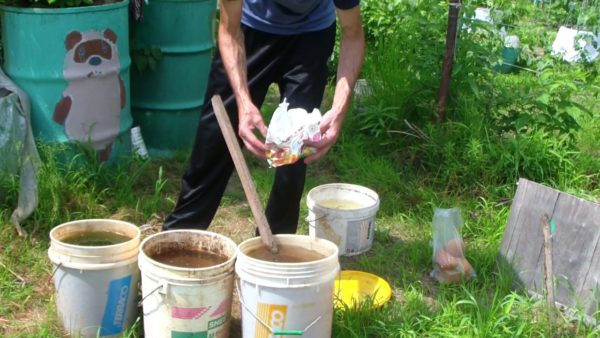
Shelter for the winter and protection from spring frosts
Grapes belong to the crops that are more suitable for a temperate climate. However, thanks to the efforts of breeders, it became possible to grow bushes in regions with severe weather conditions. If the variety has low resistance to frost or the winter temperature threshold drops below 15 °, in the fall, work is underway to create a shelter that protects the plant from freezing.
All grapes are conventionally divided into groups indicating the degree of plant resistance to frost:
- 1st group - frost resistance from -25 ° to -28 ° (the vitality of the eyes is 80-100%);
- 2nd group - from -23 ° to -27 ° (eyes save up to 60-80%);
- 3rd group - from -18 ° to -22 ° (saving eyes up to 40-60%);
- 4th and 5th groups - from -13 ° to -17 ° (the indicator of the preservation of the eyes is very low).
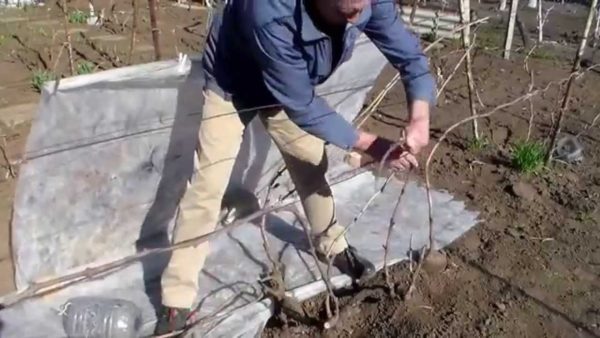
Given the variety belonging to a particular group, choose one of the more appropriate methods of shelter:
- with the help of shields and wooden boards, followed by ground powder;
- the method of instilling vines into a prepared trench (a layer of soil from 15 to 30 cm depending on the resistance group);
- wrapping with polyethylene film;
- warming bags of sugar or flour;
- wrap agrofibre vines.
There is no need to hurry or tighten with the work of weatherizing the vine: with early wrapping there is a high probability of branches bursting, and shifting the work to a later time is fraught with the freezing of individual parts or the entire bush with a sharp drop in temperature.
Grafting a vineyard
Of the many methods of grafting, gardeners enjoy the following options.
Desktop
It is necessary to inoculate in the period - February - March.The procedure is performed under ambient conditions with sterility. A week before the operation, the cuttings are taken from the storage site, and then soaked for a few minutes in a weak solution of potassium permanganate for disinfection. Next, the cuttings are wrapped in damp hessian and sent to storage at a temperature of 10-15 °.
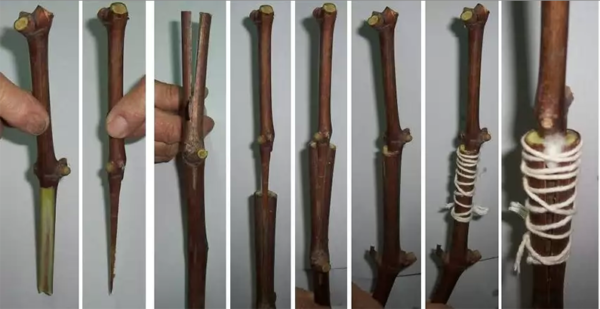
Stock is prepared 10 days before vaccination. As a rule, the strongest seedling is chosen. Its root system is shortened to 10-15 cm. Further, the stock turns into a damp cloth and is stored at a temperature of 10-15 °.
The docking site can be tightly bandaged or fixed with adhesive tape. Ideal conditions for the accretion of two parts are created when the figure cut, forming the grooves. When docked, they are tightly connected, forming a single vascular system, through which the movement of nutrients is restored.
How to instill a drill
The basis is taken shtamb, located as close as possible to the ground and having a sufficient thickness. A hole is made in it with a drill whose diameter is equal to the cutting used.Immediately after making a hole, a soaked and stripped cutting is installed. The docking place is fixed with wax or clay. Below is a simple diagram.
- Drill inoculation scheme
- Prepared materials for vaccination
Splitting method
In this way they implant last year's or more senior escape, as well as the stem obtained from an annual green vine. The vaccination site is scheduled between the second and third nodes, a longitudinal cleft of about 3 cm is made.
The prepared cutting is inserted into the burial and carefully bandaged with the graft, after which it is moistened. An important condition for survival is the temperature regime of 22-26 °. The procedure is performed with disinfected instruments and quickly, in order to prevent the working material from drying out.
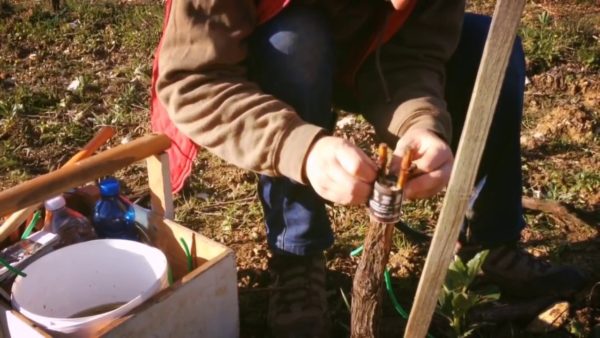
The way to bush stump
Work is done in the spring during the beginning of the movement of juice (until May). The essence of the procedure involves the removal of the old vine by cutting it off and creating a split at the cut (2-3 cm depth), where 1-2 grafts are inserted.
Stock on the site overtighten with twine and fill the dock with wax or sealed with clay. Over the basement cover film and all covered with earth. After the development of the first shoots, the hilly part can be raked.
Methods of propagation of the vine
Reproduction occurs with cuttings, grafts with stock and layering. Seeds are used only for breeding work. Grown seedlings develop poorly and bear small berries that do not have good taste. However, for the collection of genetic material seeds are of real value.
- Cuttings can be cut from the bush at any time, but the most favorable period is autumn. There are many ways to store blanks, followed by rooting and planting in open ground. The spring planting of saplings has advantages in comparison with the autumn one, because during the summer and the warm season of autumn the chubuk has time to get stronger and survive the winter frosts without much risk. Whereas a weak young shoot is prone to freezing or damage by typical diseases.
- The method of grafting with the stock provides for sawing an old vine and cuttings touched it. Rooted escape begins to develop rapidly and for the second season enters the phase of fruiting.
- Layer implies a choice on the grapes of the annual shoot, developing in the lower part and dropping it in the late autumn into a hole, the depth of which is approximately 25-30 cm. Sprinkle the top of the vine with a mixture of fertile soil and manure or compost. In the spring of prikopannoy otvodki obtained a full-fledged bush, which develops new shoots, equal to the number of buds. The following season, in spring, the vines from the cuttings are transplanted to a permanent place.
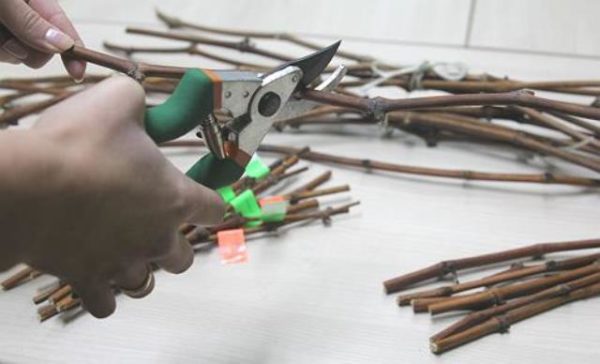
Chasing
Embossing is a procedure for removing the top of a growing sprout with leaves. The purpose of the operation is the redistribution of nutrients between all organs of the vine, while growth processes are slowed down by 3-4 weeks.
At least 16 healthy and well-developed leaves are left on the vine. A short pruning method with only 5 leaves remaining above the brush will not provide the plant with enough micronutrients. And the correct chasing stimulates the formation of large clusters and berries, the timely ripening of fruits and vines on the knots of substitution.
Terms of the procedure:
- on the bushes of early varieties, the removal of the tops is carried out in the 2-3 decade of July;
- operation was recommended for mid-varieties in early August;
- plants with a long growing season should be removed tip in late August or early September.
Knowing the finer points of growing grapes, you can grow several bushes of different varieties on your site, even for beginners. Any gardener feels special joy when he takes a generous harvest, which you can proudly boast to friends or neighbors.
